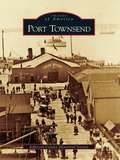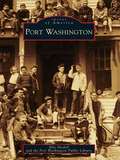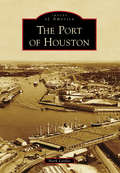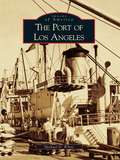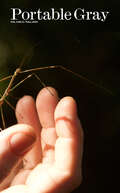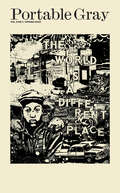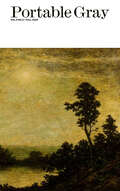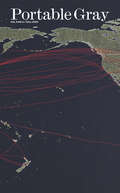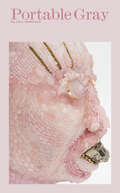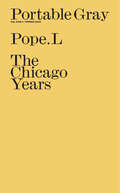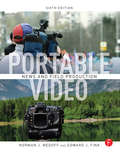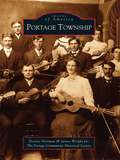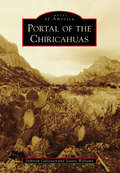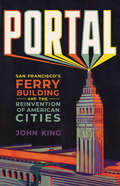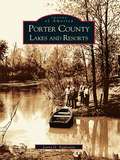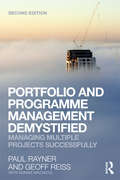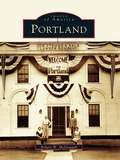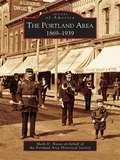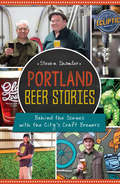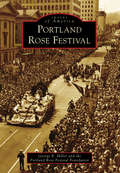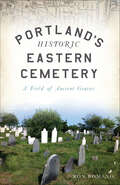- Table View
- List View
Port Townsend
by Jefferson County Historical SocietyOn Washington's Olympic Peninsula, at the entrance to Puget Sound, the Port Townsend of the 1850s was perfectly situated for sailing vessels. By 1880, thousands of ships from all over the world were passing through. Optimistic investors sought fortunes in shipping, logging, lumber mills, and land speculation. While commerce flourished at sea level, citizens built fine homes, churches, schools, clubs, a respectable shopping district, and parks uptown on the bluff. The settlers of this lovely seaport enjoyed rich cultural and social lives. Port Townsend went bust after the anticipated railroad failed to arrive. It remained largely frozen in time without economic motivation to tear down and replace its fine Victorian architecture. It wasn't until the 1970s that the beautiful setting and buildings were discovered by artists, hippies, preservationists, and, later, tourists and retirees. The town is now a thriving arts and cultural community, still beautiful, still small and remote.
Port Washington
by Richard D. Smith Port Washington Historical SocietyPort Washington is a picturesque community on the shores of Lake Michigan, just a short drive north of Milwaukee. It celebrates its 175th birthday in September 2010. This book is a vivid description of the city's history, from the Native Americans who lived on these shores when the voyageurs first arrived, through the birth of a thriving and industrious community of immigrants who settled here after leaving Germany and Luxembourg. The pages touch on the early years of industry, focusing on the maritime heritage of Port Washington, and give the reader a wonderful photographic tour of what Port Washington was like over 100 years ago. Some of these photographs have never before been published and some of the buildings no longer exist, which makes this book a treasure trove of historic images to be enjoyed by many generations.
Port Washington (Images of America)
by Elly Shodell Port Washington Public LibraryPort Washington is located 17 miles east of Manhattan on Long Island's North Shore. Once known as the "shellfish garden" of New York City, it is known for its bounteous bays, yachting and boatbuilding, celebrity residents, and pioneering aviation activities. Immigration, technology, economic changes, and geographical forces shaped Port Washington over the years. Its burgeoning aviation industry was led by the Guggenheims and Charles Lindbergh in the 1930s, and the literary and musical giants who lived here included John Philip Sousa, William Rose Benet, and Sinclair Lewis. During the war years in the 1940s, Grumman and the United States Navy set up crucial operations in Port Washington. An era of suburbanization and development soon followed, reflecting the prosperity of the 1950s and 1960s.
Port of Houston, The
by Mark LardasTo reach the Port of Houston's Turning Basin, a ship must travel 50 miles along a narrow and twisting channel that passes through Galveston Bay, the San Jacinto River, and Buffalo Bayou. Despite this improbable location, Houston has the world's largest landlocked port. Measured by annual tonnage shipped, the Port of Houston is the second-largest port in the United States. Its docks, wharves, and facilities cover more than 25 miles. The port starts its second century as a seaport in 2014. Its transformation from a crowded river port into an industrial giant is fascinating. It is a tale of technology, geography, politics, hard work, and Texas brag--mixed with a little luck.
Port of Los Angeles, The
by Michael D. WhiteThe epic of the Port of Los Angeles was initiated more than 150 years ago by a handful of visionaries and entrepreneurs who exploited both fortunate and outrageous circumstances to transform a tidal mudflat into the world's largest man-made harbor. Phineas Banning and archrival Augustus Timms were among the first to realize the potential of the coastal dent on the map called San Pedro Bay in the 1850s. The bay's namesake village expanded from a backwater loading point for raw cattle hides to a deepwater harbor rivaling and eventually surpassing San Francisco as the busiest port on the U.S. Pacific coast, and would later become the nation's largest container port. Political battles in far-off Washington, D.C., economic booms and depressions, world wars, and billions of tons of cargo and material later, the Port of Los Angeles remains America's premier revolving door for trade with markets around the world.
Portable Gray, volume 4 number 2 (Fall 2021)
by Portable GrayThis is volume 4 issue 2 of Portable Gray. Portable Gray (PG), interdisciplinary in scope and dedicated to experimentation, offers a forum for artists and scholars to consider how collaboration can enrich their practices and foster new discoveries. Encouraging contributors to play with artistic and literary forms and modes in order to challenge long-held ideas, PG features essays, interviews, poetry, art, and musical compositions, among other works.
Portable Gray, volume 5 number 1 (Spring 2022)
by Portable GrayThis is volume 5 issue 1 of Portable Gray. Portable Gray (PG), interdisciplinary in scope and dedicated to experimentation, offers a forum for artists and scholars to consider how collaboration can enrich their practices and foster new discoveries. Encouraging contributors to play with artistic and literary forms and modes in order to challenge long-held ideas, PG features essays, interviews, poetry, art, and musical compositions, among other works.
Portable Gray, volume 5 number 2 (Fall 2022)
by Portable GrayThis is volume 5 issue 2 of Portable Gray. Portable Gray (PG), interdisciplinary in scope and dedicated to experimentation, offers a forum for artists and scholars to consider how collaboration can enrich their practices and foster new discoveries. Encouraging contributors to play with artistic and literary forms and modes in order to challenge long-held ideas, PG features essays, interviews, poetry, art, and musical compositions, among other works.
Portable Gray, volume 6 number 2 (Fall 2023)
by Portable GrayThis is volume 6 issue 2 of Portable Gray. Portable Gray (PG), interdisciplinary in scope and dedicated to experimentation, offers a forum for artists and scholars to consider how collaboration can enrich their practices and foster new discoveries. Encouraging contributors to play with artistic and literary forms and modes in order to challenge long-held ideas, PG features essays, interviews, poetry, art, and musical compositions, among other works.
Portable Gray, volume 7 number 1 (Spring 2024)
by Portable GrayThis is volume 7 issue 1 of Portable Gray. Portable Gray (PG), interdisciplinary in scope and dedicated to experimentation, offers a forum for artists and scholars to consider how collaboration can enrich their practices and foster new discoveries. Encouraging contributors to play with artistic and literary forms and modes in order to challenge long-held ideas, PG features essays, interviews, poetry, art, and musical compositions, among other works.
Portable Gray, volume 7 number 2 (Fall 2024)
by Portable GrayThis is volume 7 issue 2 of Portable Gray. Portable Gray (PG), interdisciplinary in scope and dedicated to experimentation, offers a forum for artists and scholars to consider how collaboration can enrich their practices and foster new discoveries. Encouraging contributors to play with artistic and literary forms and modes in order to challenge long-held ideas, PG features essays, interviews, poetry, art, and musical compositions, among other works.
Portable Gray, volume 8 number 1 (Spring 2025)
by Portable GrayThis is volume 8 issue 1 of Portable Gray. Portable Gray (PG), interdisciplinary in scope and dedicated to experimentation, offers a forum for artists and scholars to consider how collaboration can enrich their practices and foster new discoveries. Encouraging contributors to play with artistic and literary forms and modes in order to challenge long-held ideas, PG features essays, interviews, poetry, art, and musical compositions, among other works.
Portable Video: ENG & EFP
by Norman Medoff Edward J. FinkPortable Video: ENG and EFP, Fifth Edition" focuses on the techniques and technology of single camera electronic news gathering and electronic field production. Covering everything from basic creative and technical editing techniques to budgets and copyright issues, it is accessible to the home videomaker or amateur and to the professional seeking information on the newest advances in technique and equipment. It includes special focus on TV news production and field production and is suitable for complete beginners.
Portage Township (Images of America)
by James Wright The Portage Community Historical Society Dennis NormanIt has been over 40 years since the trinity of Crisman, McCool, and Garyton united to become Portage, Indiana. Located 50 miles from downtown Chicago on the shores of Lake Michigan, Portage Township has emerged as a growing residential, commercial, and industrial center. Portage became a town in 1959 and attained city status in 1967, but the region's history begins with the indigenous Wey Indians of the 1700s and the Potowotamie, whose land was sold in 1834. Pioneers then settled the land alongside immigrants. For many generations Portage has offered a new beginning to those who sought work, political asylum, or simply a better life.
Portal of the Chiricahuas (Images of America)
by Jeanne Williams Deborah GallowayCoronado scorned this region as unpopulated when he labored through southeastern Arizona in 1540, but he could have found 12,000-year-old spear points in the remains of giant bison near Cave Creek Cienega, grinding hollows in boulders, and shamanic figures in high caves of the Chiricahuas towering above valleys and grasslands. Searing drought forced people to abandon their villages by 1400, but Apaches wandered down from Canada about the time Spaniards passed by. Thousands of forty-niners traveled in sight of the mountains on their race to California. The Chiricahua Apaches were exiled to Florida in 1886; even earlier, their lands were opened to settlement. Portal began in 1902 as a rest stop between the railroad and the boom town of Paradise. Since 1956, the Southwestern Research Station of the American Museum of Natural History has attracted countless researchers. The present community is a vibrant mix of biologists, birders, astronomers, writers, artists, and ranchers, united by love for this unique canyon.
Portal: San Francisco's Ferry Building and the Reinvention of American Cities
by John KingA two-time Pulitzer finalist explores the story of American urban design through San Francisco’s iconic Ferry Building. Conceived in the Gilded Age, the Ferry Building opened in 1898 as San Francisco’s portal to the world—the terminus of the transcontinental railway and a showcase of civic ambition. In silent films and World’s Fair postcards, nothing said “San Francisco” more than its soaring clocktower. But as acclaimed architectural critic John King recounts in Portal, the rise of the automobile and double-deck freeways severed the city from its beloved structure and its waterfront—a connection that required generations to restore. King’s narrative spans the rise and fall and rebirth of the Ferry Building. Rich with feats of engineering and civic imagination, his story introduces colorful figures who fought to preserve the Ferry Building’s character (and the city’s soul)—from architect Arthur Page Brown and legendary columnist Herb Caen to poet Lawrence Ferlinghetti and Senator Dianne Feinstein. In King’s hands, the saga of the Ferry Building is a microcosm of a larger evolution along the waterfronts of cities everywhere. Portal traces the damage inflicted on historic neighborhoods and working dockyards by cars, highways, and top-down planning and “urban renewal.” But when an earthquake destroyed the Embarcadero Freeway, city residents seized the chance to reclaim their connection to the bay. Transporting readers across 125 years of history, this tour de force explores the tensions impacting urban infrastructure and public spaces, among them tourism, deindustrialization, development, and globalization. Portal culminates with a rich portrait of San Francisco’s vibrant esplanade today, visited by millions, even as sea level rise and earthquakes threaten a landmark that remains as vital as ever. A book for city lovers and visitors, architecture fans and pedestrians, Portal is essential reading for anyone interested in the history of San Francisco and the future of American cities.
Porter County Lakes and Resorts
by Larry G. EgglestonThe history of Porter County goes back several centuries. The area now known as Porter County was first inhabited by several Indian tribes, primarily the Potawatomi. With the formation of the state of Indiana and the establishment of Porter County, the area grew rapidly. The natural beauty of Porter County and its scenic freshwater lakes attracted developers who erected several summer resorts around the lake area. Access to these resorts was enhanced by the construction of the interurban electric railroad, which offered visitors easy access to the area's offerings.
Portfolio and Programme Management Demystified: Managing Multiple Projects Successfully
by Geoff Reiss Paul RaynerYou’re now responsible for a programme, or you’ve got a portfolio to manage? Where do you start? Right here! Projects are not simply the bread and butter of an organisation. Form them into programmes or portfolios and they can be prioritised and integrated to deliver change to your organization in line with your strategic vision. You will be able to control costs and risks and bring together a complex series of themes effectively. This overhauled second edition now combines portfolio management as a parallel theme with programme management, and it is brought in line with the current thinking of the Association for Project Management and the Project Management Institute. It is written for managers in both the public and private sectors. This new edition includes half a dozen short case studies (from Belgium’s Fortis Bank, a software company, local government, and central government), along with more on cross-functional management. Together with Project Management Demystified, also from Routledge (third edition, 2007), it provides the tools to manage your projects, your programmes and your portfolio to a very high level.
Portfolios for Interior Designers
by Maureen MittonThe complete guide to portfolio development for interior designersIt's a widely known fact that interior designers need a strong visual presence in the form of a well-crafted, professional-looking portfolio. Surprisingly, however, many interior designers aren't equipped with the expertise required to organize and unify their work in a fashion that optimally conveys their talents and skills.Portfolios for Interior Designers helps demystify the process by guiding the reader toward mastery in assembling a winning portfolio. It delivers essential step-by-step instruction presented in a manner that shows interior designers how to properly and effectively display their designs. This book also includes:Color and black-and-white illustrations showing portfolio elements and optionsGraphic design concepts necessary for portfolio developmentSpecific information for the design of digital portfoliosSupplemental teaching resources that direct readers to a companion Web siteUseful tips on the ways that popular graphics software applications can be best implemented for certain portfolio elementsSamples of cover letters and resumes, along with discussion of job search proceduresWith the aid of real-world examples, Portfolios for Interior Designers examines how a portfolio can be used as an effective tool for communicating with clients and other professionals. A much-needed guide, this book eliminates the uncertainty surrounding portfolio development so that interior designers can showcase their abilities success-fully--and land the next job.
Portland
by Robert W. McdougallPortland is located in "the big bend" of the Connecticut River near the center of the state, where natural resources provided a prosperous livelihood for generations of residents. First settled as part of Middletown, the area was incorporated as Portland in 1841. The town is known for its brownstone quarries, the Gildersleeve shipyard, and shade-grown tobacco. Meshomasic, the first state forest in New England, is located here. In Portland, historic photographs drawn from the archives of the Portland Historical Society and from private collections take the reader on a journey through the rich history of this quiet small town, now known for its golf courses and marinas.
Portland
by Walter FortnerThe year was 1901, and Portland, Oregon, was celebrating its 50th birthday, having grown from a community of 821 people to become the largest city in the Pacific Northwest. A small change in postal regulations that year opened the door to the production of the picture postcard, and collecting these cards quickly became a popular hobby. Many of these cards survive today and provide a glimpse of life in days gone by. Collected here are many rare images of Portland: grand hotels and magnificent buildings, the natural beauty of the surrounding area, the great bridges, and splendid sailing ships. The world's fair honoring the centennial of the Lewis and Clark expedition and the annual Rose Festival inspired enough cards to fill their own books.
Portland Area, The: 1869-1939
by Portland Area Historical Society Mark D. NeeseIn the early 1830s, a man named Elisha Newman made the first land claim in the area that later became Portland, Michigan. Newman was attracted by the excellent location at the confluence of the Grand and Looking Glass Rivers. He was not the first to be drawn to this area, as it had already been occupied for many years by the Chippewa and Ottawa tribes of Native Americans. After its 1836 settlement by European Americans, Portland steadily grew into an economic and industrial center of Ionia County. In 1869, Portland was incorporated as a village. This book contains nearly 200 photographs and illustrations that both document and celebrate life in the Portland area from 1869 through the years just prior to World War II, a time when the banks of the Grand and Looking Glass Rivers were teeming with industry and the downtown streets were bustling with activity.
Portland Beer Stories: Behind the Scenes with the City's Craft Brewers (American Palate)
by Steven ShomlerPortlanders have got it made. Not only is the city filled with nearly countless breweries, brewpubs, bottle shops and homebrew supply venues, but also the people who created the community are nothing short of fascinating. Saddle up to the bar and get to know the stories of the men and women brewing some of the country's most exciting beer and cider, from the origin of Ecliptic Brewing to a personal account of a beer truck driver. When you are looking for an adventure outside the city limits, try out one of the seven beer road trips to other Northwest towns (with a designated driver, of course). Join author Steven Shomler for a hop through Brewvana.
Portland Rose Festival (Images of America)
by George R. Miller Portland Rose Festival FoundationAt the end of the Lewis and Clark Exposition in 1905, the president of the Portland Street Fair and Carnival Association, E.W. Rowe, presented the idea of an annual festival to Portland mayor Harry Lane. From that idea came the first Rose Festival, called the Rose Carnival and Fiesta, held June 20-22, 1907. It was hailed as a huge success. "There is no reason in the world why Portland should not hold a rose festival every year," remarked the Oregonian on June 21. "Everyone will be happier and better all the rest of the year for the festival of roses." And indeed, that has been the case. From just a three-day event, the Rose Festival has expanded over the years to include many activities covering several months every spring and summer.
Portland's Historic Eastern Cemetery: A Field of Ancient Graves (Landmarks)
by Ron RomanoA window into the past of Historic Eastern Cemetery, illuminating centuries of Portland's history through the stories of those laid to rest.Eastern Cemetery holds more than 350 years of Portland's rich history. From bank robbers and murdering mutineers to Quakers and war heroes, the lives of those interred offer a window into the past. Within the sacred burial ground rest settlers who struggled with the natives over resources, citizens who had to choose their allegiance to the king or independence and abolitionists fighting for the end of slavery. Author and cemetery guide Ron Romano tells the fascinating tale of this historic landscape, illuminating centuries of Portland's history through the stories of those laid to rest.
